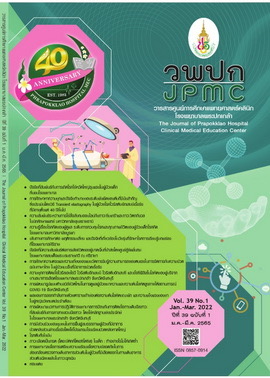Prevalence of HIV, HBV, HCV and Syphilis Infection in Blood Donors at Blood Bank Department, Prapokklao Hospital, Chanthaburi Province
Main Article Content
Abstract
BACKGROUND: Blood is produced naturally by a human body. Whenever there is an illness that requires patients to receive blood for treatment, there is a need to find replacement for blood. The important and necessary procedures for safe blood recruitment are selection of healthy and low-risk donors, and effective laboratory screening for infection in donated blood.
OBJECTIVE: To study the prevalence of HIV, Hepatitis B, Hepatitis C and Syphilis infection among blood donors at the Blood Bank, Prapokklao Hospital, Chanthaburi Province.
METHODS: This descriptive study aimed to collect the historical data of blood donors at the Blood Bank, Prapokklao Hospital as well as mobile blood donation units in Chanthaburi Province between January 1, 2019 and December 31, 2020, regardless of gender, address or age for eligibility. Exclusion data included platelet donation or other blood components. There were unsuccessful blood collections because blood donors had adverse reactions while collecting, such as fainting, bruising, and swelling at the puncture sites, and the blood supply not being up to standards.
RESULTS: In 2019, there were a total of 33,289 donors divided into 24,903 in-house at 74.8%, and 8,387 by mobile units at 25.2% with a standard blood donation of 73.8%. In 2020, there were a total of 33,192 donors divided into 26,624 in-house at 80.1%, and 6,598 in mobile units at 19.9% with a standard blood donation of 69.9%. In 2019 and 2020, the male and female proportion was 50.5% per 49.5% and the age with the highest donor range of 21-30 years was 30.3% with an average 2-year prevalence of infection at 0.2%, divided into 0.5% for the highest prevalence of HBV, followed by syphilis 0.2%, HCV 0.1% and HIV 0.1%, respectively.
CONCLUSIONS: The results of this study show that, among blood donors in Chanthaburi Province, HBV infection was found the most and there was a tendency for HBV infection to be higher with prevalence of 0.4% and 0.5 % in 2019 and 2020, respectively. Therefore, safe donor blood acquisition from the process of recruiting blood donors should involve effective screening and laboratory testing.
Article Details

This work is licensed under a Creative Commons Attribution-NonCommercial-NoDerivatives 4.0 International License.
References
National AIDS Control Organisation. Ministry of Health and Family Welfare Government of India. Standards for blood banks & bloods transfusion services. New Delhi: NACO; 2007
Gibbs WN, Britten AFH. Guidelines for the organization of a blood transfusion service. Geneva: World Health Organization; 1992.
Trakulkaseamsiri S, Thapyotha C. Prevalence of hepatitis B, hepatitis C, HIV and syphilis infection in first-time blood donors at Queen Savang Vadhana Memorial Hospital, Thai Red Cross Society, during 2007-2011. Bull Chiang Mai Assoc Med Sci 2012;45(2):15-21.
Urwijitaroon Y. Donor selection: strategy for reduction of transfusion risk. Thai Journal of Hematology and Transfusion Medicine 2007;17:145-53.
National Blood Centre, Thai Red Cross Society. Donor selection guideline. 5th ed. Bangkok: National blood centre, The Thai red cross Society; 2011
Blood Donation Thai, The Thai red Cross Society. National blood policy 2022-2027. Bangkok: Udomsuksa; 2021.
Wongkham S. Infection rate of HIV virus hepatitis B virus hepatitis C virus and syphilis in blood donation of Hua Hin Hospital. Chiangrai Medical Journal 2017; 9( 2):105-13.
Ingkhanant S ,Chanachaisuwan P. Prevalence of infections among blood donors at Police General Hospital. J Hematol Transfus Med 2015; 25: 107-13.
Jaddee A. Prevalene of HlV, hepatitis B, hepatitis C and syphilis infections among blood donors. Medical Journal of Sisaket Surin Burirum Hospital 2012; 8: 197-206.

